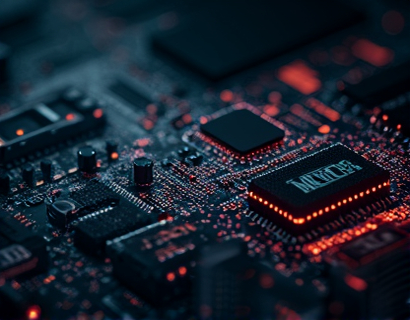DeFi Trading Revolutionized: Mastering Automated Market Makers for Enhanced Automation and Liquidity
The decentralized finance (DeFi) space has witnessed a transformative shift with the advent of Automated Market Makers (AMMs), revolutionizing the way traders interact with liquidity and execute trades. This evolution has empowered crypto enthusiasts and traders alike to harness the full potential of decentralized markets, offering enhanced automation, liquidity management, and trading efficiency. This article delves into the intricacies of AMMs, exploring how they are reshaping the DeFi trading landscape and providing insights into optimizing your trading experience through advanced smart-contract technology.
Understanding Automated Market Makers
Traditional market makers in centralized exchanges manually manage liquidity and set bid-ask spreads to facilitate trades. In contrast, AMMs operate on smart contracts deployed on blockchain networks, automating the process of liquidity provision and trade execution. The core mechanism of an AMM revolves around a liquidity pool, where users deposit pairs of tokens to create a pool from which traders can borrow, lend, or exchange tokens. The value of each token in the pool is determined by a mathematical formula, typically a constant product equation, ensuring that the product of the token quantities remains constant.
The most common AMM model is the Constant Product Market Maker (CPMM), where the product of the quantities of two tokens in a pool (x * y) remains constant. This model is implemented in popular AMMs like Uniswap and Curve. The simplicity and transparency of these models attract a growing number of users seeking a more decentralized and automated trading experience.
Enhanced Liquidity Management
One of the primary advantages of AMMs is their ability to provide liquidity in a more efficient and accessible manner. Traditional order books in centralized exchanges can suffer from illiquidity, leading to wider spreads and less favorable trade execution prices. AMMs mitigate this issue by maintaining a constant liquidity pool, ensuring that trades can be executed at any time without significant impact on the pool's liquidity.
Moreover, AMMs allow for continuous liquidity provision, enabling users to earn passive income through liquidity mining programs. These programs reward users with native tokens or other incentives for providing liquidity to pools, further encouraging participation and enhancing the overall liquidity in the DeFi ecosystem. This mechanism not only benefits liquidity providers but also improves market depth and reduces slippage for traders.
Automated Trading Strategies
AMMs facilitate the implementation of sophisticated automated trading strategies, leveraging the power of smart contracts to execute trades based on predefined criteria. One such strategy is arbitrage, where traders exploit price discrepancies across different DeFi platforms. AMMs enable real-time arbitrage by allowing traders to automatically rebalance their positions across multiple pools, ensuring they capture profits from price differences.
Another advanced strategy is yield farming, where users deploy their tokens to various DeFi protocols to earn compound interest and additional rewards. AMMs play a crucial role in yield farming by providing liquidity to protocols that offer lending and borrowing services, thereby enhancing the efficiency and accessibility of these services. By automating the process of token deployment and rebalancing, traders can focus on optimizing their strategies rather than managing the underlying mechanics.
Optimizing Trade Execution
The automation offered by AMMs significantly enhances trade execution efficiency. Unlike traditional exchanges where traders manually place orders and wait for execution, AMMs execute trades instantly based on the smart contract's logic. This instant execution reduces the risk of missed opportunities and ensures that trades are executed at the most favorable prices available in the pool.
Additionally, AMMs often incorporate features like liquidity provision thresholds and fee structures that incentivize optimal trade execution. For instance, some AMMs offer lower fees for larger trades, encouraging users to pool their tokens for more significant transactions. This not only improves the overall trading experience but also promotes more substantial liquidity contributions to the ecosystem.
Enhancing Market Efficiency
The decentralized nature of AMMs contributes to a more efficient and transparent market. All transactions are recorded on the blockchain, providing a tamper-proof and auditable trail. This transparency builds trust among users and reduces the risk of manipulation or fraudulent activities. Furthermore, the open-source nature of many AMM protocols allows developers to audit and improve the code, fostering a community-driven approach to enhancing security and functionality.
AMMs also facilitate cross-chain liquidity, enabling traders to access and trade assets across different blockchain networks. This interoperability breaks down silos and creates a more interconnected DeFi ecosystem, offering traders a broader range of opportunities and enhancing market liquidity on a global scale.
Challenges and Considerations
While AMMs offer numerous benefits, they also come with challenges that traders and developers must address. One significant concern is the impermanent loss faced by liquidity providers, where the value of their tokens can decrease relative to holding them outside the pool due to price fluctuations. Understanding and managing impermanent loss is crucial for liquidity providers to make informed decisions.
Another consideration is the complexity of smart contracts, which, if not properly audited, can pose security risks. Users should prioritize using well-audited and reputable AMMs to minimize the risk of smart contract vulnerabilities. Additionally, the volatile nature of crypto assets means that traders must stay informed and adapt their strategies to changing market conditions.
Future Prospects
The future of DeFi trading is bright, with AMMs continuing to evolve and integrate new features to enhance user experience and market efficiency. The development of more sophisticated AMM models, such as those incorporating variable product formulas, can further optimize liquidity and trading dynamics. Additionally, the integration of AMMs with other DeFi protocols, like decentralized exchanges (DEXs) and lending platforms, will create a more seamless and interconnected ecosystem.
As the DeFi space matures, we can expect increased adoption of AMMs by institutional investors and traditional financial institutions, bringing more capital and credibility to the space. The ongoing innovation and community support will drive the development of more user-friendly and feature-rich AMM solutions, solidifying their position as a cornerstone of the DeFi revolution.
In conclusion, Automated Market Makers are revolutionizing DeFi trading by providing enhanced automation, liquidity management, and trading efficiency. By leveraging the power of smart contracts, AMMs offer a transparent, efficient, and accessible trading experience, empowering users to navigate the dynamic crypto market with greater ease and confidence.











































